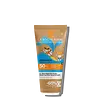La Roche-Posay Anthelios Dermo-Pediatrics Wet Skin Lotion SPF 50+ Versus Nivea Kids Sensitive Protect Sun Spray SPF 50+
What's inside
What's inside
 Key Ingredients
Key Ingredients

 Benefits
Benefits

 Concerns
Concerns

 Ingredients Side-by-side
Ingredients Side-by-side

Water
Skin ConditioningHomosalate
Skin ConditioningDrometrizole Trisiloxane
UV AbsorberEthylhexyl Salicylate
UV AbsorberBis-Ethylhexyloxyphenol Methoxyphenyl Triazine
Skin ConditioningEthylhexyl Triazone
UV AbsorberGlycine
BufferingButyl Methoxydibenzoylmethane
UV AbsorberIsohexadecane
EmollientAlcohol Denat.
AntimicrobialPropanediol
SolventDicaprylyl Ether
EmollientStyrene/Acrylates Copolymer
Dimethicone
EmollientAcrylates/Dimethicone Copolymer
Skin ConditioningP-Anisic Acid
MaskingAscorbyl Palmitate
AntioxidantCarbomer
Emulsion StabilisingDisodium EDTA
Glyceryl Oleate
EmollientHydrogenated Palm Glycerides Citrate
EmollientLecithin
EmollientNylon-12
PEG-8 Laurate
EmulsifyingPhenoxyethanol
PreservativeTocopherol
AntioxidantTriethanolamine
BufferingWater, Homosalate, Drometrizole Trisiloxane, Ethylhexyl Salicylate, Bis-Ethylhexyloxyphenol Methoxyphenyl Triazine, Ethylhexyl Triazone, Glycine, Butyl Methoxydibenzoylmethane, Isohexadecane, Alcohol Denat., Propanediol, Dicaprylyl Ether, Styrene/Acrylates Copolymer, Dimethicone, Acrylates/Dimethicone Copolymer, P-Anisic Acid, Ascorbyl Palmitate, Carbomer, Disodium EDTA, Glyceryl Oleate, Hydrogenated Palm Glycerides Citrate, Lecithin, Nylon-12, PEG-8 Laurate, Phenoxyethanol, Tocopherol, Triethanolamine
Water
Skin ConditioningAlcohol Denat.
AntimicrobialButyl Methoxydibenzoylmethane
UV AbsorberEthylhexyl Triazone
UV AbsorberBis-Ethylhexyloxyphenol Methoxyphenyl Triazine
Skin ConditioningIsopropyl Palmitate
EmollientC12-15 Alkyl Benzoate
AntimicrobialDibutyl Adipate
EmollientButylene Glycol Dicaprylate/Dicaprate
EmollientDiethylamino Hydroxybenzoyl Hexyl Benzoate
UV FilterGlyceryl Stearate
EmollientGlycerin
HumectantPhenylbenzimidazole Sulfonic Acid
UV AbsorberChamomilla Recutita Flower Extract
MaskingTocopheryl Acetate
AntioxidantMicrocrystalline Cellulose
AbsorbentCellulose Gum
Emulsion StabilisingXanthan Gum
EmulsifyingC18-38 Alkyl Hydroxystearoyl Stearate
EmollientCopernicia Cerifera Wax
Hydrogenated Rapeseed Oil
EmollientCetyl Palmitate
EmollientSodium Stearoyl Glutamate
CleansingSodium Hydroxide
BufferingMaltodextrin
AbsorbentSodium Chloride
MaskingHydroxyacetophenone
AntioxidantEthylhexylglycerin
Skin ConditioningCaprylyl Glycol
EmollientTrisodium EDTA
Water, Alcohol Denat., Butyl Methoxydibenzoylmethane, Ethylhexyl Triazone, Bis-Ethylhexyloxyphenol Methoxyphenyl Triazine, Isopropyl Palmitate, C12-15 Alkyl Benzoate, Dibutyl Adipate, Butylene Glycol Dicaprylate/Dicaprate, Diethylamino Hydroxybenzoyl Hexyl Benzoate, Glyceryl Stearate, Glycerin, Phenylbenzimidazole Sulfonic Acid, Chamomilla Recutita Flower Extract, Tocopheryl Acetate, Microcrystalline Cellulose, Cellulose Gum, Xanthan Gum, C18-38 Alkyl Hydroxystearoyl Stearate, Copernicia Cerifera Wax, Hydrogenated Rapeseed Oil, Cetyl Palmitate, Sodium Stearoyl Glutamate, Sodium Hydroxide, Maltodextrin, Sodium Chloride, Hydroxyacetophenone, Ethylhexylglycerin, Caprylyl Glycol, Trisodium EDTA
Ingredients Explained
These ingredients are found in both products.
Ingredients higher up in an ingredient list are typically present in a larger amount.
Alcohol Denat. is an alcohol with a denaturant property. It is created by mixing ethanol with other additives.
This ingredient gets a bad rep because it is irritating and drying - mostly due to its astringent property. Astringents draw out natural oils in tissue, constricting pores and leaving your skin dried out.
However, alcohol denat. is not all that bad.
Due to its low molecular weight, alcohol denat. tends to evaporate quickly. One study on pig skin found half of applied alcohol evaporated in 10 seconds and less than 3% stayed on skin.
This also helps other ingredients become better absorbed upon application.
Studies are conflicted about whether this ingredient causes skin dehydration. One study from 2005 found adding emollients to propanol-based sanitizer decreased skin dryness and irritation. Another study found irritation only occurs if your skin is already damaged.
Small amounts of alcohol are generally tolerated by oily skin or people who live in humid environments.
The rule of thumb is if this alcohol is near the end of an ingredients list, it will probably not affect your skin much.
Also...
This ingredient has antimicrobial and solvent properties.
The antimicrobial property helps preserve products and increase their shelf life. As a solvent, it helps dissolve other ingredients.
Other types of astringent alcohols include:
Learn more about Alcohol Denat.You might know this ingredient as Tinosorb S or Bemotrizinol. It is a UV filter that covers both UVA and UVB rays.
This ingredient has two peak UV absorption peaks ( 310 and 340 nm) and is able to absorb both UV-A and UV-B rays. This ingredient works by preventing UV rays from reaching and damaging your skin.
On top of that - it is highly photostable and helps prevent the photodegration of other sunscreen ingredients such as avobenzone.
Tinosorb S is allowed in the EU, Australia, and Asia. It is close to being approved by the FDA and we'll hopefully get this ingredient in the U.S. by late 2025.
Fun fact: Tinosorb S is the most effective UV absorber at maximum concentration (measured by SPF) permitted in the EU.
This ingredient is oil-soluble, so your oil-cleansers will take this right off at night.
Learn more about Bis-Ethylhexyloxyphenol Methoxyphenyl TriazineAlso known as Avobenzone, this ingredient is a chemical sunscreen filter that provides protection in the UV-A range.
Avobenzone is globally approved and is the most commonly used UV-A filter in the world.
Studies have found that avobenzone becomes ineffective when exposed to UV light (it is not photostable; meaning that it breaks down in sunlight). Because of this, formulations that include avobenzone will usually contain stabilizers such as octocrylene.
However, some modern formulations (looking at you, EU!) are able to stabilize avobenzone by coating the molecules.
Avobenzone does not protect against the UV-B range, so it's important to check that the sunscreen you're using contains other UV filters that do!
The highest concentration of avobenzone permitted is 3% in the US, and 5% in the EU.
Learn more about Butyl MethoxydibenzoylmethaneEthylhexyl Triazone is a modern chemical sunscreen that protects from UV-B radiation.
It is the most effective of existing UV-B filters, as it provides the highest level of photo-stable absorption. It protects from the entire UV-B range (280 to 320nm), with it's highest level of protection at 314nm.
Ethylhexyl Triazone is oil soluble, oderless and colorless, which mean it is able to be incorporated into a variety of different formulations.
It is not currently available within the United States due to slow changing FDA regulations. Outside of the US, it is used in formulations at concentrations up to 5%.
Learn more about Ethylhexyl TriazoneWater. It's the most common cosmetic ingredient of all. You'll usually see it at the top of ingredient lists, meaning that it makes up the largest part of the product.
So why is it so popular? Water most often acts as a solvent - this means that it helps dissolve other ingredients into the formulation.
You'll also recognize water as that liquid we all need to stay alive. If you see this, drink a glass of water. Stay hydrated!
Learn more about Water